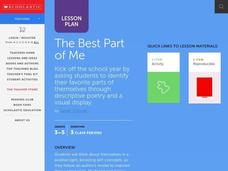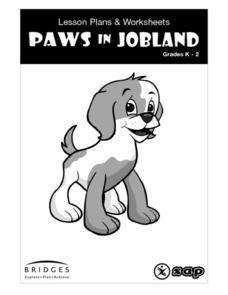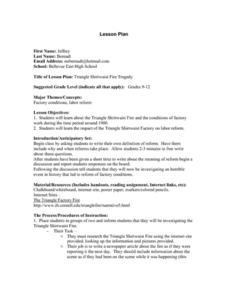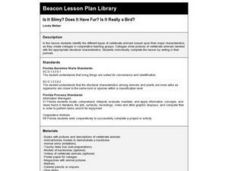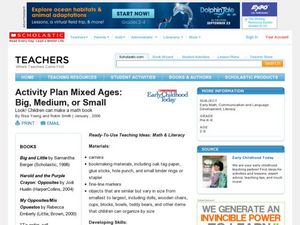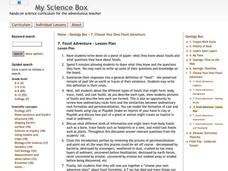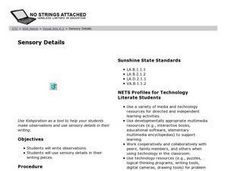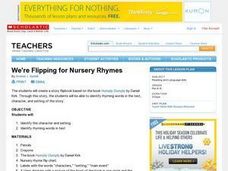Curated OER
Antebellum North Carolina
Eighth graders examine pictures & documents relating to the Hayes Plantation (Edenton, NC). They also use various maps of North Carolina to help them analyze how James Cathcart Johnston used, modified and adapted to the physical...
Curated OER
Best Part of Me
Students determine a positive physical feature of themselves. They participate in an online writer's workshop and write descriptive poem about their favorite feature. They create a display of poetry and pictures.
Curated OER
Amazing Australia (Grade K)
Students listen as the teacher reads "Possum Magic" to them. They watch the movie of the book, and create a T graph illustrating the differences and similarities between the book and movie. They research an animal and print a picture in...
Curated OER
Activity Plan 4-5: Riddles by the Bagful!
Young scholars write a riddle to be included in a class riddle book. In this creative-thinking lesson, the teacher will introduce children to riddles, then guide children through the process of writing and illustrating their own riddles...
Curated OER
Cinderella Stories
Students read and compare Cinderella stories using a worksheet. They write and illustrate original tales with a twist.
Curated OER
Texture With Chemical Reactions
Students explore the use of different textures in watercolor paintings in this late-elementary lesson plan. Emphasis is placed upon the art element of texture using the science of chemical reaction. The lesson plan includes one...
Curated OER
Publishing a Magazine
Students work collaboratively to create, edit, and publish their own student magazine. The lesson suggests the use of iPhoto, a word processor, iPages, and digital cameras for the creative process.
Curated OER
Johnny Tremain/Boston Tea Party
Fifth graders understand chronological order of events. In this Boston Tea Party lesson, 5th graders compare the events surrounding the Boston Tea Party to current times. Students learn vocabulary and customs of the revolutionary times....
Curated OER
Imaginary Insect Zoo
Students create imaginary insects that contain essential characteristics of an insect, such as six legs and three body parts. In this Science/Arts lesson, students distinguish between an insect and non-insect. Students create their own...
Curated OER
The Gingerbread Person
Students discuss gender bias and stereotyping. In this social science lesson, students read the book "The Gingerbread Boy" and discuss why it is a boy. Students then write their own story changing it to a gingerbread girl and a female fox.
Curated OER
We're Alike, We're Different!
Students compare a variety of people counters to determine how they're alike and different and then sort, classify and write about how they sort and classify people counters.
Curated OER
The "Reading Rainbow" Series
Second graders watch a show to gather information about a career. In this careers lesson, 2nd graders watch Reading Rainbow and participate in a class discussion about the occupation presented in the show. Lesson includes extension ideas.
Curated OER
Triangle Shirtwaist Fire Tragedy
Students research the Triangle Shirtwaist Fire. In this labor reform lesson, students research the fire and write a newspaper article report from the perspective of the time. Students evaluate the perspective of the workers and create...
Curated OER
Characteristics and Functions of Money
Fourth graders discuss the function and characteristics of money. For this financial education lesson plan, 4th graders read the book The Go-Around Dollar by Johnston Adams. This book sparks a conversation on how money is used and the...
Curated OER
Favorite Foods
Students draw a picture. In this favorite foods lesson, students list the foods they like to eat and form each like into a complete sentence. Students cut the word in the sentences apart and then arrange them in the correct order with a...
Curated OER
Mother's Day Story Time Activities
Young scholars examine all of the jobs a mother does. In this Mother's Day lesson, the teacher read the book Five Minutes' Peace, then students brainstorm a list of things their mother does. Young scholars role play the job of a mom...
Curated OER
Imaginary Insect Zoo
Students construct imaginary insects. In this insect lesson, students will discover the anatomy of their favorite insect and apply it to their own creation. Student will write a description of their model, and put the insect models...
Curated OER
Animal Names
Students match animal pictures with animal words. In this farm animal lesson, students put together the parent and their offspring. Students should have prior knowledge of the basic needs of animals. Students write animal booklets.
Curated OER
Is It Slimy? Does It Have Fur? Is It Really a Bird?
Sixth graders identify the different types of vertebrate animals based upon their major characteristics, as they create collages in groups. Collages show pictures of vertebrate animals labeled with the appropriate structural...
Curated OER
Activity Plan Mixed Ages: Big, Medium, or Small
Students make a math book. In this early childhood math lesson plan, students develop language, observation, and math skills as they explore the sizes of objects and use cameras to take pictures for their own math booklet based on...
Curated OER
Fossil Adventure
Students create a book about the process of a dinosaur becoming a fossil. In this earth science instructional activity, students are taught about fossils and create a book that tells what happened to a dinosaur's bones after they die.
Curated OER
Sensory Details
Students observe their environment and write detailed, sensory-specific sentences about that environment. This activity can be extended to include the creation of a personalized story or movie of the experience (student examples are...
Curated OER
We're Flipping for Nursery Rhymes
Students read a variety of nursery rhymes with a focus on "Humpty Dumpty". While reading, they identify the words that rhyme along with the setting, plot and characters. To end the activity, they complete a Venn Diagram comparing...
Curated OER
Have Block Party!
Students discover that the possibilities are limitless in this block-building activity. In this early childhood, problem solving lesson, students develop social, problem-solving, math, and language skills using a specific number of...



